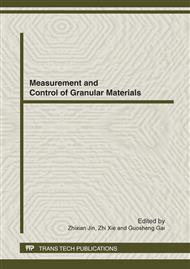[1]
Darr, J. A., & Poliakoff, M. (1999). New Directions in Inorganic and Metal-Organic Coordination Chemistry in Supercritical Fluids. Chem Rev, 99(2), 495-542.
DOI: 10.1021/cr970036i
Google Scholar
[2]
Kawasaki, S. -i., Xiuyi, Y., Sue, K., Hakuta, Y., Suzuki, A., & Arai, K. (2009).
Google Scholar
[3]
Lester, E., Blood, P., Denyer, J., Giddings, D., Azzopardi, B., & Poliakoff, M. (2006). Reaction engineering: The supercritical water hydrothermal synthesis of nano-particles. Journal of Supercritical Fluids, 37(2), 209-214.
DOI: 10.1016/j.supflu.2005.08.011
Google Scholar
[4]
Zhang, Z. C., Brown, S., Goodall, J. B. M., Weng, X. L., Thompson, K., Gong, K. N., et al. (2009). Direct continuous hydrothermal synthesis of high surface area nanosized titania. Journal of Alloys and Compounds, 476(1-2), 451-456.
DOI: 10.1016/j.jallcom.2008.09.036
Google Scholar
[5]
Thompson, R. W., & Dyer, A. (1985). A Modified Population Balance Model for Hydrothermal Molecular-Sieve Zeolite Synthesis. Zeolites, 5(5), 292-301.
DOI: 10.1016/0144-2449(85)90161-7
Google Scholar
[6]
Sheikh, A. Y., Jones, A. G., & Graham, P. (1996). Population balance modeling of particle formation during the chemical synthesis of zeolite crystals: Assessment of hydrothermal precipitation kinetics. Zeolites, 16(2-3), 164-172.
DOI: 10.1016/0144-2449(95)00116-6
Google Scholar
[7]
Lummen, N., & Kvamme, B. (2008). Determination of nucleation rates of FeCl2 in supercritical water by molecular dynamics simulations. Journal of Supercritical Fluids, 47(2), 270-280.
DOI: 10.1016/j.supflu.2008.07.017
Google Scholar
[8]
Nahtigal, I. G., Zasetsky, A. Y., & Svishchev, I. M. (2008). Nucleation of NaCl nanoparticles in supercritical water: Molecular dynamics simulations. Journal of Physical Chemistry B, 112(25), 7537-7543.
DOI: 10.1021/jp709688g
Google Scholar
[9]
Erriguible, A., Mariasi, F., Cansell, F., & Aymonier, C. (2009).
Google Scholar
[10]
Sierra-Pallares, J., Teresa Parra-Santos, M., García-Serna, J., Castro, F., & José Cocero, M. (2009).
DOI: 10.1016/j.supflu.2009.05.001
Google Scholar
[11]
Chen, M., Ma, C. Y., Mahmud, T., Darr, J. A., & Wang, X. Z. (2011).
Google Scholar
[12]
Costa, C. B. B., Maciel, M. R. W., & Maciel, R. (2007). Considerations on the crystallization modeling: Population balance solution. Computers & Chemical Engineering, 31(3), 206-218.
DOI: 10.1016/j.compchemeng.2006.06.005
Google Scholar
[13]
Li, X., Chen, Z., Shi, Y., & Liu, Y. (2011). Preparation of N, Fe co-doped TiO2 with visible light response. Powder Technology, 207(1-3), 165-169.
DOI: 10.1016/j.powtec.2010.10.024
Google Scholar
[14]
Mockel, H., Giersig, M., & Willig, F. (1999). Formation of uniform size anatase nanocrystals from bis(ammonium lactato)titanium dihydroxide by thermohydrolysis. Journal of Materials Chemistry, 9(12), 3051-3056.
DOI: 10.1039/a905373e
Google Scholar
[15]
Cai Y. Ma, Christopher J. Tighe, Robert I. Gruar, Tariq Mahmud, Jawwad A. Darr, Xue Z. Wang* (2011).
Google Scholar


